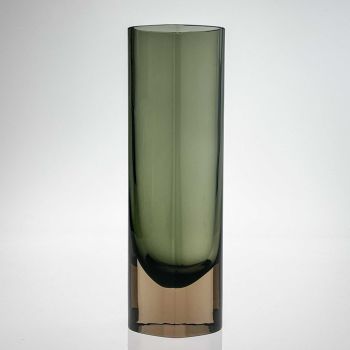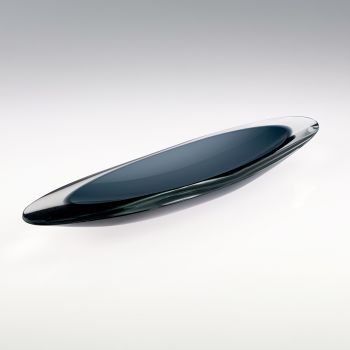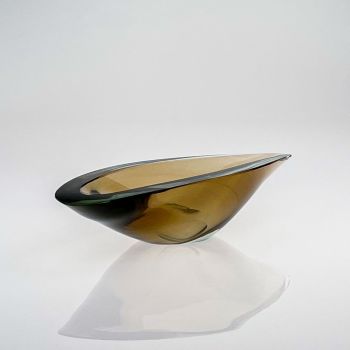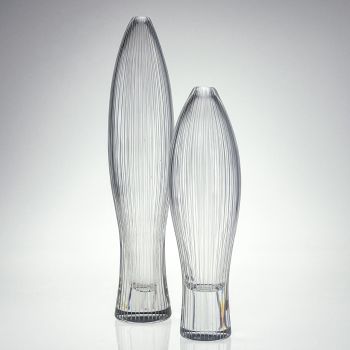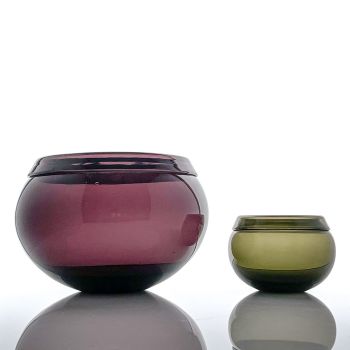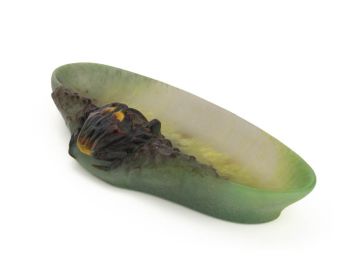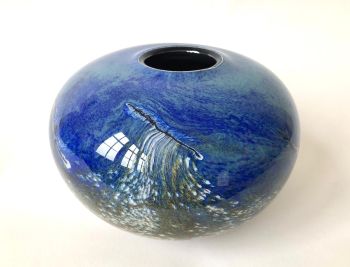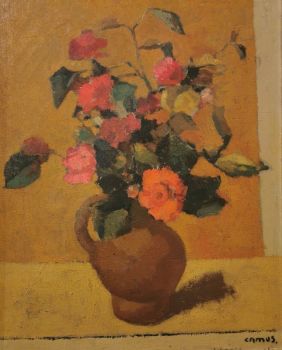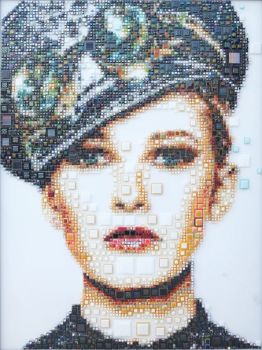Glass Art-object “Prisma”, model KF 215 in brown and grey hues – Nuutajärvi-Notsjö, Finland 1962 1962
Kaj Franck
Copo
13 ⨯ 9 ⨯ 7 cm
ConditionVery good
€ 750
Van Kerkhoff Art
- Sobre arteA free blown, cased glass, facet cut Art-object “Prisma”, model KF 215, in brown and grey hues. Designed by Kaj Franck in 1953 and executed by the Nuutajärvi-Notsjö glassworks, Finland in 1962.
These rare vases were made between 1954 and 1968 in four different sizes ranges, this example falls within the second smallest size range. It is fully marked and dated underneath the base in diamondpen: K. Franck Nuutajärvi-Notsjö ’62 (1962).
About Kaj Franck
Kaj Franck (Vyborg, Finland 1911 – Santorini, Greece 1989), a pioneering Finnish designer and a prominent figure in the Finnish art world from 1940 to 1980, left an indelible mark on the design landscape. Today, his name is synonymous with excellence and innovation, as exemplified by the prestigious “The Kaj Franck Design Prize,” which is annually awarded by the esteemed Finnish Design Forum.
Born in 1911 on the Finnish-Russian border into a family with a rich architectural heritage, Franck had design in his blood. His grandfather held a prominent position as the director of the renowned Arabia Ceramics factory, underscoring the influence and inspiration that surrounded him from an early age.
Franck pursued his passion for design by studying at the furniture department of Taideteollinen korkeakoulu, known today as the Aalto University School of Arts, Design, and Architecture, in Helsinki. Equipped with a solid foundation in design principles, he embarked on a career as a freelance designer before joining Arabia in 1945. It was during his time at Arabia that Franck’s talent truly flourished, and in 1950, he assumed the role of the company’s Artistic Director.
While his contributions to Arabia were significant, Franck’s creative vision extended beyond ceramics. He also designed glass objects for Iittala between 1946 and 1950, and later for Nuutajärvi-Notsjö glassworks from 1950 to 1976. His designs, particularly in everyday tableware and glassware, propelled him to the forefront of the design world. Notably, his iconic Kilta tableware and Kartio glassware are celebrated as revolutionary and enduring symbols of classic Finnish design.
Franck’s design philosophy embodied a profound commitment to principles of moderation, ecology, and equality. Often referred to as “the conscience of Finnish design,” he advocated for minimalism and the conscious reduction of everyday objects, emphasizing the importance of sustainability and product life cycles. Franck’s designs were a testament to his belief that beauty and functionality could coexist harmoniously, enhancing the lives of individuals while respecting the environment.
Recognized for his exceptional contributions, Franck’s works grace the collections of esteemed museums worldwide. Noteworthy institutions such as the Design Museum Helsinki, the Museum of Modern Art in New York, the Stedelijk Museum Amsterdam, and The British Museum in London all proudly display his creations. Throughout his illustrious career, Franck received numerous accolades, including the prestigious Lunning Prize in 1955, as well as “Grand Prix” and multiple “Gold Medals” at the renowned Triennale di Milano.
Kaj Franck’s enduring legacy rests not only on his remarkable designs but also on his unwavering commitment to advancing the field of design. His vision, which emphasized sustainability, simplicity, and social consciousness, continues to inspire designers and enthusiasts alike, ensuring that his influence will be felt for generations to come.
Marked
Signed in diamondpen; K. Franck – Nuutajärvi-Notsjö – '62 (1962)
Execution
Nuutajärvi-Notsjö glassworks, Finland 1962
Condition
This Prisma is in good vintage condition. Some light scratches and wear consistent with age and use. No further chips or cracks.
Literature
Marianne Aav (ed.), Kaj Franck, Universal Forms, p.222, p.323
Dimensions
Height 13 cm
Width 9 cm
Depth 6,5 cm
Weight 563 grams - Sobre artista
O designer finlandês de cerâmica e vidro Kaj Franck (1911-1989) percebeu uma verdade poderosa em sua distinta carreira: simples é belo. Apesar do mundo se mover em um ritmo cada vez mais rápido, de uma década para outra, essa simples verdade permanece. A inspiração e os princípios de Franck deram início a uma tradição no design finlandês, que ainda hoje está viva e forte. Seus trabalhos mais conhecidos são as séries Iittala Teema e Kartio, e sua herança faz parte de todos os lares finlandeses.
"Eu quero fazer uso de objetos que são tão óbvios que não são perceptíveis", Kaj Franck definiu seu próprio trabalho. Seus projetos atendiam às necessidades humanas básicas, servindo-lhes ferramentas com propriedades de objetos do cotidiano. produção em massa de custo e materialismo evitado, cultura descartável e ostentação. O mundo de Franck consistia em formas matemáticas básicas e formas simples, decoradas apenas com cores fortes.
O ponto de partida do trabalho de Franck foi a praticidade aliada à beleza. Embora pareça evidente hoje, em seu próprio tempo seus pensamentos eram radicais. Franck separou os estilos e as tendências da moda da tradição e deu-lhes um novo significado. No período de 1952-53, Franck mostrou que a louça não precisa ser excessivamente complexa com o lançamento da série Kilta como uma afirmação forte - era uma ideia inovadora que todos pudessem fazer os arranjos de mesa de acordo com suas próprias necessidades .
Franck começou seus projetos concentrando-se na ideia ou conceito subjacente, não na forma. Essa ênfase no aspecto da ideia do design também foi levada ao seu trabalho como professor e, posteriormente, como diretor artístico na Universidade de Arte e Design em Helsinque. Franck também foi um dos primeiros defensores da reciclagem e muitas vezes foi chamado de "consciência do design finlandês". Franck ganhou muitos prêmios em sua distinta carreira e tornou-se internacionalmente famoso. Hoje, o Kaj Franck Award é o reconhecimento de design de maior prestígio da Finlândia .
Você está interessado em comprar esta obra de arte?
Artwork details
Related artworks
- 1 - 4 / 9
Børge Mogensen
Teak wood “dropleaf” desk – Søborg Møbler, Denmark circa 19551950 - 1960
Prix sur demandeVan Kerkhoff Art
1 - 4 / 24Artiste Inconnu
François-Théodore Legras – Tall “Fleurs de Pommier” apple blossoms vase1900 - 1909
Prix sur demandeAntiques Emporium
Amalric Walter
Amalric Walter & Henri Bergé – Crabe plumier1920 - 1929
Prix sur demandeAntiques Emporium
1 - 4 / 24Paulus Franciscus Kromjong
Fleurs devant Arearea Aka (joie) par Gauguin '20th century
Prix sur demandeZebregs & Röell - Fine Art - Antiques
René Lalique
Un très rare vase «Fougères» vert foncé conçu par R. Lalique1912
€ 8.950Lennart Booij Fine Art and Rare Items
 Sélectionné par
Sélectionné parSilla Scheepens
Artiste Inconnu
A Japanese bronze Hu flower vase, Edo / Meiji, 19th century19th century
Prix sur demandeMenken Works of Art
1 - 4 / 24Johann Loetz (Lötz) Witwe Klostermühle
Johann Loetz Witwe - Phänomen Genre 7773 – Orange1900 - 1910
Prix sur demandeAntiques Emporium
Artiste Inconnu
Verre à boire Cristallo façon de Venise1600 - 1650
Prix sur demandePeter Korf de Gidts - Antiquairs
1 - 4 / 24- 1 - 4 / 12









